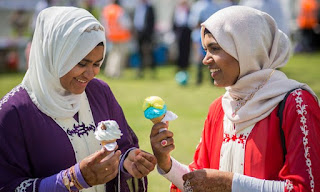This week's topic is focused on a culture that is very dear to me, the Polynesian Culture. So I will be mixing things up a little and will share some of my favorite parts about my culture and how I will able to apply it to my nursing care.
ALOHA!
Most people are familiar with this famous phrase, but within the in Polynesian Culture, warm greetings are a cherished part of the culture. The word "Aloha" can mean many things, but most commonly it means hello, goodbye, and love. By using this expression with friends, family, and even strangers it shows trust, friendship, love, kindness, affection, and compassion. Interestingly enough, visitors who go to the Hawaiian islands must abide by the spirit of Aloha by sharing good feelings amongst one another. So whenever an someone shares the expression of Aloha, it is expected to reciprocate the same warm greeting.
This is me and my handsome husband who has now become very much apart of the Polynesian Culture ;)
This image is from when I danced in the Snow College Luau (I'm the tall one in the middle)
Another thing the Polynesian Culture is widely known for is their love for food. It is no secret that Polynesians take strong pride in how they prepare and serve their food. One of my favorite dishes involves Auntie's Mac salad, Kalua pork, fried spam, chicken long rice, and of course; fresh pineapple! (I seriously could eat this everyday!) Now because the islands of Hawaii include such diverse ethnicities all who add their own flavors, styles, and ingredients the tastes of the Polynesian Culture seem to become more vibrant and tasty! Food serves as a way to gather friends, family, and strangers together to share the spirit of the Polynesian Culture.
This is Auntie's Kalua pork, Mac Salad, teriyaki chicken, and seasoned fruit.
#nursingbyCOURTNEY
I think because the Polynesian Culture is something I understand and am apart of, I will be able to use this knowledge to help me understand more about other cultures. I also think that I will be able to apply my culture by sharing it with others and helping coworkers, friends, and patients know more about my own culture. I think by sharing our own cultures with others we are able to help change stereotypes and increase cultural awareness. I think if we understand other individuals cultures we are more able to give better care and find ways to connect with our patients. Additionally, I believe that each health care providers can have a large positive effect on cultural care by simply recognizing others and their cultural beliefs and practices.
Courtney's "Two-Cent's" Cheeeeeee-Hooooooo!!!!
In all honesty I have been waiting all semester to talk about the Polynesian Culture, simply because I am personally tied and connected to this culture. I have such a love and pride for the Polynesian people and I want to continue to share my love for the culture by leaving my positive influence on others. It is my hope that as I go throughout my life I will be able to leave a happy and positive impression on the Polynesian Culture. What a joy it has been to be apart of this class to be able to learn more about all the other cultures, and gain a better understanding of how I can improve my cultural awareness.
Here are some images from my experiences in dancing in Luau's
http://www.alternative-hawaii.com/hacul/beliefs.htm
All images personal owned.

























